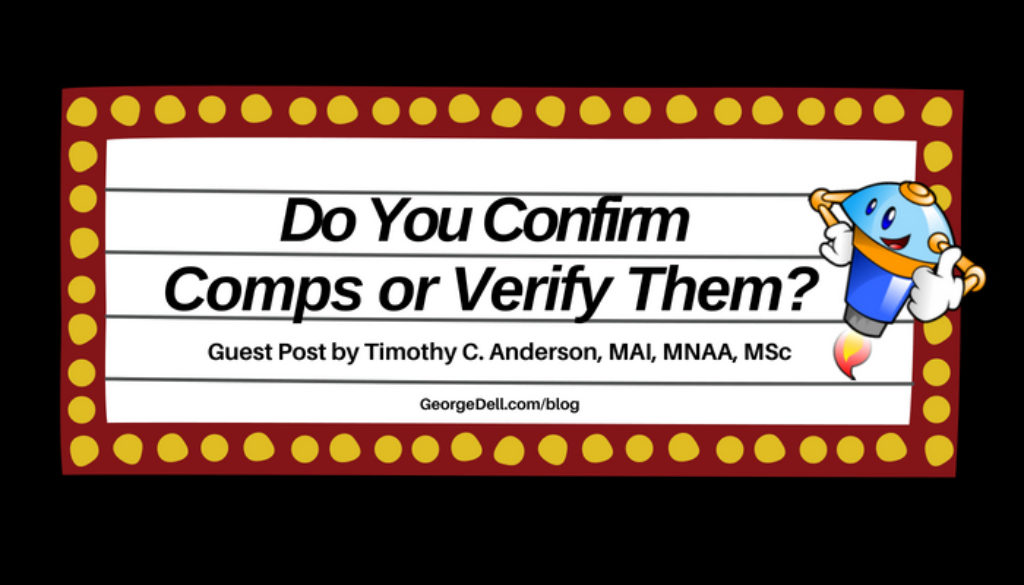This week’s blog, Do You Confirm Comps or Verify Them? is a guest post written by Timothy C. Andersen, MAI, MNAA, MSc, CDEI. See below for a more detailed bio.
Do you confirm your comps or verify them?
Is there a discernible difference between “confirm” and “verify”? Is one the due diligence of a professional? Do our efforts provide our clients with the benefits and advantages they do not get from mere machines?
USPAP’s SR1-4 is clear: it is the appraiser’s responsibility to “…collect, verify, and analyze all information necessary for credible assignment results” (emphasis added). A regression analysis, without the appraiser’s judgment to leaven it, does not provide this advantage. USPAP makes it clear the appraiser is to verify all of the facts s/he uses in forming a value conclusion, not merely confirm them. This verification, then, provides the client with an advantage our digitized competition cannot and will not do.
The meanings of confirm and verify are distinct. To “confirm” means “…to establish the truth or correctness of something previously believed, suspected, or feared to be the case”, (see https://www.google.com/#q=define+confirm). To “verify” carries the meaning of “…making sure or demonstrating that something is true, accurate, or justified…” (see https://www.google.com/#q=define+verify), which is why USPAP requires verification. It takes an appraiser who can judge when a sale and purchase is arm’s-length to verify those data. To verify is more proactive, more complete, more muscular than is to confirm.
Verification requires external evidence (that was not there before), whereas confirmation is merely support to what you already knew (or suspected – ibid). The difference between to verify and to confirm is due diligence, a task an algorithm is incompetent to complete. Due diligence is a synonym for proper service to the client, part of what leads the appraiser to a credible value opinion. A credible value opinion “…promote[s] and maintain[s] a high level of public trust in appraisal practice…” (see USPAP’s Preamble), as well as in appraisers, something an algorithm cannot do.
As we verify comparable data, which is what USPAP both demands and expects, our clients see our professionalism, our expertise, the benefits to them of our education & training, and a reason to compensate us fairly when they reap the benefits of our efforts, benefits they cannot glean from a cold, impersonal AVM. This requires effort and patience on our part, but we can change their attitudes. We do that by showing them we provide them with more benefits, more advantages, than the use of mere machinery.
TIMOTHY C. ANDERSEN, M.Sc., MAI, CDEI, MNAA is a Florida state certified general appraiser. In addition to his work helping appraisers defend themselves against charges of USPAP violation, teaching USPAP, and helping appraisers write USPAP compliant reports, he enjoys spending time riding his bike and doting on his grandchildren. Contact him at tim@theappraisersadvocate.com.

June 20, 2018 @ 5:21 am
Thanks to Mr. Andersen for the very well written article. I just wish all my competitors agreed.
Jack Poe, M.Sc., MAI, AI-GRS
June 20, 2018 @ 7:55 am
I see where you are going with this, but I believe there’s a lot of hair-splitting going on. In your use of Google’s definition of “verify” the word “or” should have been highlighted instead of “demonstrating.” Had you used the entire definition, you would have seen the word “confirm” used as a synonym. This can also be confirmed/verified by Merriam Webster, English by Oxford Dictionaries, http://www.thesarus.com, etc. I have a question for you. When you use say, 100 sales from the MLS in your regression analysis, do you verify that the information in every one of those sales is correct?
June 20, 2018 @ 8:16 am
Thank you, Jack!
June 20, 2018 @ 8:35 am
This was a great article with some clear and understandable explinations sounds of the differences. Tim Anderson is the gold standard in appraising and teaching.
July 5, 2018 @ 10:43 am
There’s a problem here…what exactly constitutes confirmation OR verification today? Is a data source like CoStar adequate? In many cases it is difficult or impossible to get someone with knowledge of the transaction to return a phone call. Brokers and principals will say they have better thing to do. Information from public sources is sometimes accurate, and sometimes now.